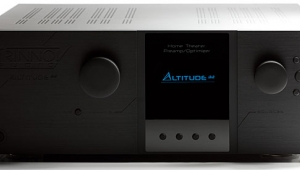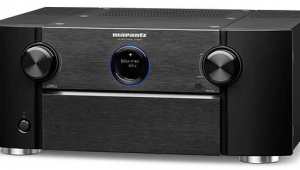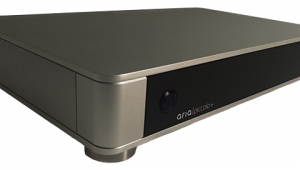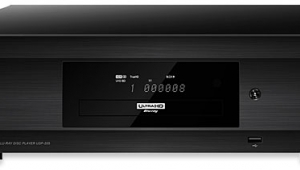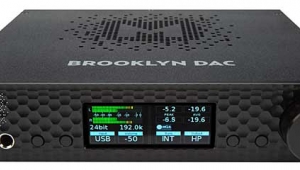| Columns Retired Columns & Blogs |
Music in the Round #32
Last time in "Music in the Round," I wrote about the fading presence of SACD in the hardware and software markets. However, the enduring interest in LPs seems to tell us that where there is a demand for high quality by discerning audiophiles, there will be a supply.
There is a reasonably vigorous release schedule for high-definition music videos on Blu-ray, in all genres, including opera and ballet. My experience has been that these discs' higher audio and video resolution makes them of more enduring interest than standard-definition DVDs, but nonetheless, the music bears repetition better than does the video. In addition, some performances are of little or no visual interest, and the cost of video production must be a drag on the profits. So where are the audio-only hi-rez discs?
 AIX Records has been making them for years, and now offers their hi-rez recordings via download, too, at iTrax. Last year we saw a series of HD DVD music-only discs from Surround Records, but the HD DVD format has since been abandoned. Recently, Surround began supporting Blu-ray and supplemented the first series, which were sophisticated synthesizer renditions of classics, with a new series of audio discs (with some video content) remastered from some of the best multichannel recordings in the Naxos catalog. Producer Alexander Jero assures me that the front three channels are identical to the Naxos originals, but that his new 7.1-channel mixes offer an expanded presentation.
AIX Records has been making them for years, and now offers their hi-rez recordings via download, too, at iTrax. Last year we saw a series of HD DVD music-only discs from Surround Records, but the HD DVD format has since been abandoned. Recently, Surround began supporting Blu-ray and supplemented the first series, which were sophisticated synthesizer renditions of classics, with a new series of audio discs (with some video content) remastered from some of the best multichannel recordings in the Naxos catalog. Producer Alexander Jero assures me that the front three channels are identical to the Naxos originals, but that his new 7.1-channel mixes offer an expanded presentation.
The best news is of the appearance of the very first (as far as I know) music-only Blu-ray disc, from 2L Records. The label, the source of some of the tastiest SACDs of the past six months, has released Divertimenti, a lovely program of works for strings by Bacewicz, Bartók, Bjørklund, and Britten, performed by the Trondheim Soloists (2L50SABD). It was recorded in DXD as 24-bit data at 352.8kHz per channel: four times the data content of DSD on SACD, which leaves more headroom for editing and balancing.
While the performances are delightful and recorded in very immersive surround sound, the formats of the release make it fine fare for the obsessive audiophile. First, as an introductory offer, 2L includes in a single jewelcase a hybrid SACD and a Blu-ray disc, both for the price of a single CD. The SACD includes 16-bit/44.1kHz "Red Book" and DSD two-channel tracks, and a 5.1-channel DSD track, the two DSD tracks at the standard SACD resolution of 2.8224Mbits/s/ for each channel. The Blu-ray is even more fully packed: a 24/192 LPCM two-channel track, and four 5.1-channel tracks: 48kHz-sampled Dolby Digital, 24/192 Dolby TruHD, 24/192 DTS-HDMA, and 24/192 LPCM. Leaving out all the video except for some simple menus leaves a lot of elbow room for the sound!
This set invites comparisons of all the different mixes and resolutions. All are quite good, and each is a paradigm of excellence for its particular codec—even the CD-compatible tracks. In fact, I invite you to begin your comparisons there and take one of two routes, depending on your equipment. Two-channel fans should see if the DSD and/or LPCM tracks offer any enhancements, but if you're using only your player's analog output, any distinctions will be constrained by the player's DAC and analog stages. Owners of multichannel players have more options, encompassing the stereo options as well as all the lossy and lossless tracks on the Blu-ray disc.
Via my modified Oppo DV-980H and Meridian 861 processor, the already lovely CD was bested by the DSD stereo version, which removed from the highs a bit of artificial sheen. Going to the multichannel DSD mix was simply unfair: the two-channel tracks put all the musicians up front, whereas the multichannel tracks place the listener in the middle of the ensemble. Comparisons among the various multichannel tracks were a bit bewildering because of the different source components and connections required: different players for SACD and Blu-ray, of course, but the Anthem Statement D2 preamp/processor currently in my system would accept none of the HD codecs, and its upper LPCM limit is 96kHz. Downconverting everything to 24/48 LPCM was doable but pointless.
If you're as curious as I am about what the optimum format might be for HD multichannel music on Blu-ray, get Divertimenti and form your own opinions. I'll swap around equipment in the coming weeks, report what I find next time, and we can compare notes.
Anthem Statement D2 audio/video processor
Anthem's Statement D2 has been in the field for two years now, and has earned a solid reputation for its audio and video performance as well as for Anthem's continual updating of its software to fix minor glitches and add enhancements. It was the latest such enhancement, Anthem Room Correction (ARC), that at last inspired me to request a review sample. The Statement D2 with ARC costs $7499; ARC can be added to a D2 in the field for $399.

I've played with many equalization (EQ) and room-correction devices, and more are on the way. While none has been perfect in operation or results, I've learned that carefully applied electronic corrections can be extremely helpful—if only because too few of us pay enough attention to physical acoustical treatments, and even fewer have acoustically perfect rooms. For example, my weekend listening room is nearly a half-cube; even with treatments placed in corners and on wall, room EQ can make a huge difference there. My weekday room, however, is more generously proportioned and less heavily treated; there, room EQ makes subtle but still greatly appreciated differences. I could add more treatments there, and then perhaps not need EQ, but sufficiently treating my weekend room would render it uninhabitable.
The most important corrections needed are below the so-called the Schröder frequency, where the soundfield is dominated by the presence of standing waves. (A formula for calculating the Schröder frequency can be found here.) In most domestic listening rooms, the Schröder frequency lies between 200 and 300Hz, a range that greatly affects the weight and timbre of human voices. Unfortunately, the lower the frequency of the offending standing wave, the bulkier and more physically imposing the acoustical treatment needed. Nor can we simply apply EQ to the subwoofer and be done with it, as it's necessary to keep the sub's crossover at 80Hz or lower, to avoid disturbing localization of the sounds it produces. Thus, even with good bass management—and certainly without it—corrections for the room's modal signature must be applied to all channels. Above the Schröder frequency, the more random interactions behave like a diffuse field, which is not correctable in the same ways, but is also not as pernicious. Room treatments for higher frequencies are more easily accommodated, so it would be nice to be able to choose how to apply any electronic corrections.
Enter the Anthem Statement D2 and Anthem Room Correction. When I saw ARC in action at the 2008 Consumer Electronics Show, several things impressed me. First, it's a relatively inexpensive add-on; the D2's DSP can handle the workload, and the ARC kit contains the software, calibration microphone, mike stand, and cables—all you provide is a computer. Second, ARC displays the measured, targeted, and programmed frequency responses, to help you correlate ARC's operations with what you hear. Third, it's fairly controllable in useful ways. For example, you can accept or modify the recommended crossovers for bass management, the insertion of a variable room-gain bump, or, most significant, set the upper-frequency limit for corrections. (You can find an overview of the Statement D2's general capabilities here and here. Here, I discuss only ARC.)
The ARC software is matched to the mike and Statement D2 serial numbers. Installing the software on my laptop was uneventful, and both the mike and the D2 connect directly to it. Required are a USB port for the mike and a serial port for the D2, but a handy serial-to-USB adapter permits an all-USB setup. The mike stand is okay, but I found it easier to use the mike with my own adjustable stands. Taking measurements with the mike is identical with ARC's Standard and Advanced modes; Anthem advises doing the former first, because you can always manipulate the results afterward. I preferred Advanced mode; I like the semblance of control. ARC will not do speaker setup, nor will it calculate the speaker distances (get a tape measure), so it's essential to first do a full traversal of the D2's setup menus.
ARC can handle up to 10 measurement positions but it requires that the first mike position be at the primary listener's head position. Because I usually listen alone, I used only five positions in the vicinity of my preferred seat, separated from each other by about 2', as advised by Anthem. The latest versions of ARC handled the measurements smoothly, distinguishing good catches of the data from those requiring repetition due to a low signal/noise ratio, and calculated the optimal crossover frequencies for bass management.
In my weekend system, my left Paradigm Reference Studio/60 speaker is 3.5' from a solid corner, the center speaker is close to the middle of the front wall, and the right is next to an open doorway. However, ARC, despite having measured and displayed very apparent response differences among the three front speakers, determined that correction was needed only up to 5000Hz. Here was where ARC's ability to display measured, targeted, and corrected responses began to loom large. I returned to Advanced mode and fiddled with the target responses. I left the targets/corrections for Movies as is, and changed only the targets/corrections for Music, so that I might compare the results. I changed the upper correction limit to 20kHz (I also tried 10kHz and 15kHz), and reduced the Room Gain setting (a boost from the low midrange down into the bass, applied to compensate for the mastering lab's assumption that the listener's room is not flat) from +4dB to +1.5dB; I liked that better than no Room Gain.
I then let ARC recalculate the corrections and upload them to the Statement D2. ARC's Standard-mode results in Movie mode were very nice, especially compared to no EQ at all, but were a bit overripe (still too much Room Gain), and lacked treble air and detail (too little HF, and/or a treble skewed to the left channel). When I switched to Music mode on the fly, the soundstage opened up across the entire frequency spectrum—immediately, the system sounded right.
Of course, I'd already been listening to the ARC-less Statement D2 for a while, and knew that its basic sound quality was high and honest. Sans ARC, the D2 sounded more warm and balanced than the Integra DTC-9.8 A/V processor without the latter's Audyssey MultiEQ XT. If anything, I heard a satisfying lack of treble glint from the ARC-less D2, although the bass, so much influenced by the room, was hard to judge. Remarkably, the sound of the D2's analog inputs was just as enjoyable as that of the digital input, and the digitized multichannel analog input was nearly indistinguishable from the pass-through. This is license to enjoy all the DSP and ARC amenities of the Anthem Statement D2 without any analog angst.
Using the optimized ARC Advanced settings elevated my system's performance to a new level. For example, when I'd reinstalled my Paradigm Studio speakers after spending months with the delicious and costlier Canton Vento Reference 9 DCs, I'd been a bit deflated. Anthem's ARC told me that the biggest component of my disappointment was that I hadn't gotten around to doing the room EQ I've become so reliant on. The Studios may lack a bit of the ultimate clarity of the Ventos, but they're no slackers. In fact, they sound darn good. Moreover, with ARC, complex surround balances, which depend on accurate timbral balancing of the front Studio 60s with the Studio 20s in the room's rear corners, were as good as with Vento Reference 9DCs all around.
- Log in or register to post comments


